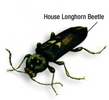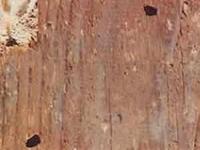Hylotrupes bajulus
 The House Longhorn Beetle is one of the biggest wood boring beetles you will find in the UK. Fortunately it is only prevalent in one specific part of the UK, namely the northwest of Surrey. It’s fortunate if you don’t live in northwest Surrey anyway. Not only is it one of the biggest, it is also one of the most damaging and can cause real problems if you get an infestation. The House Longhorn Beetle is one of the biggest wood boring beetles you will find in the UK. Fortunately it is only prevalent in one specific part of the UK, namely the northwest of Surrey. It’s fortunate if you don’t live in northwest Surrey anyway. Not only is it one of the biggest, it is also one of the most damaging and can cause real problems if you get an infestation.
As with nearly all cases of woodworm, it is not the beetle itself which causes most of the damage, in fact they are usually just responsible for the exit holes you see on the surface. Most of the damage is caused while the beetle is in its larval stage, which is why it is called “woodworm” rather than, say, “woodbeetle.” Actually the beetle spends most of its life as larva, only surviving days or weeks as an adult, with the sole purpose of mating.
The lifecycle of the House Longhorn Beetle is much the same as the lifecycle of any other wood boring beetle. The eggs are laid in the crevices of a piece of wood, or timber. The House Longhorns hatch in two or three weeks times, emerging as larva. The larva then bores through the wood, and in the case of the House Longhorn, makes oval tunnels, producing bore dust which is cylindrical and compact. Unlike most woodworm, which tends to leave the structure of the wood more or less intact in most cases, the House Longhorn often consumes the majority of the piece of wood, leaving only a surface layer behind. If you suspect you have a woodworm problem then you should get in contact with a professional in order to make a survey of the wood and the rest of your property. This is especially important in the case of House Longhorn Beetles due to the extensive damage they usually cause.
 Once the larvae have run their course, which will be anything from three to in some cases eleven years, it enters the pupal stage. This is when the larva transforms to the beetle, and this stage lasts about three weeks. The adult then eats its way up and out of the wood, leaving an oval exit hole about 3 to 7mm at its widest point. The adult beetle varies in length, anything between 8 and 25mm. It has long “horns” (hence the name), is brown and black, and has two spots on its thorax. When the weather is sunny they often fly. They always come out in summer, which is also the period when they lay their eggs. Once the larvae have run their course, which will be anything from three to in some cases eleven years, it enters the pupal stage. This is when the larva transforms to the beetle, and this stage lasts about three weeks. The adult then eats its way up and out of the wood, leaving an oval exit hole about 3 to 7mm at its widest point. The adult beetle varies in length, anything between 8 and 25mm. It has long “horns” (hence the name), is brown and black, and has two spots on its thorax. When the weather is sunny they often fly. They always come out in summer, which is also the period when they lay their eggs.
If you do live in Surrey, then the building regulations state that the timbers in the roof have to be treated to prevent an infestation of House Longhorn Beetles. Other wood may be in danger though. They tend to prefer the sapwood of spruce, pine and fir, or any softwood really. Occasionally they will go for the heartwood as well. Even if you do not live in Surrey, however, there is still a chance that you will have an infestation of House Longhorn Beetles so be on the lookout and get professional help as soon as possible if you suspect an infestation.
|